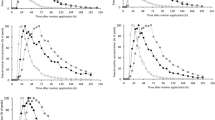Abstract
The stomach compartments of 51 Mongolian gazelles (Procapra guttrurosa) were weighed and the data were compared with total body weight. The total tissue weights ranged from 2.70% to 2.82% of body weight. Rumens were the heaviest, occupying about 75% of the total stomach, followed by reticulums (9%–11%), abomasums (8%–10%) and omasums (4%–6%). The weights of rumens were directly proportional to body weights and weights of omasums and abomasums were inversely related to body weights. Stomachs of the Mongolian gazelle were of the “mixed feeder” in terms of total weight and contribution of each compartment.
Similar content being viewed by others
References
Bell, R.H.V. 1971. A grazing ecosystem in the Serengeti. Sci. Am.,225:86–93
Chivers, D.J. and Hladik, C.M. 1980. Morphology of the gastrointestinal tract in primates: comparisons with other mammals in relation to diet. J. Morphol.,166:337–386
Church, D.C. and Hines, W.H. 1978, Ruminoreticular characteristics of elk. J. Wildl. Manage,42:654–659
Demment, M.W. and Van Soest, P.J. 1982. Body size, digestive capacity and feeding strategies of Herbivores. Morrilton, Arkansas: Winrock International Livestock Research Publication
Gao Zhongxin, Jin Kun, Ma Jianzhanget al. 1995. Winter food habits of Mongolian gazelle in Hulunberer Grassland. Acta Theriologica Sinica,15:203–20
Geist, V. 1974. On the relationship of social evolution and ecology in ungulates. Am. Zool.14:205–220
Hakonson, T.E. and Whiicher, F.W. 1971. The contribution of various tissues and organs to total body mass in the mule deer. J. Mammal,52:628–630
Hofmann, R.R. 1973. The ruminant stomach. E. Afr. Monogr. Biol. Vol. 2. E. Afr. Lit. Bureau, Nairobi, Kenya, 354pp
Hu, Shing Tsung, Hannaway, D.B. and Youngberg, H.W. 1992. Forage resources of China. Wageningen, Netherlands. Center for Agricultural Publishing and Documentation (Pudoc): 327pp
Hungate, R.E. 1966, The rumen and its microbes. New York and London, Academic Press: 533pp
Jarman, P.J. 1974. The social organization of antelope in relation to their ecology. Behavior,48:215–267
Jiang Zhaowen, Xu Li and Zheng Hong. 1991. The comparative analyses on age identification indexes of Mongolian gazelle. Chinese Wildlife,3:25–28
Nagy, J.G. and Regelin, W.L. 1975. Comparison of digestive organ size of three species. J. Wildl. Manage.,39: 621–624
Seiki Takatsuki. 1988. The weight contribution of stoamch compartments of Sika doer. J. Wildl. Manage.,52: 313–316
Short, H.L. 1964. Postnatal stomach development of whitetailed deer. J. Wildl. Manage.,28: 445–458
Author information
Authors and Affiliations
Additional information
Responsible editor: Zhu Hong
Rights and permissions
About this article
Cite this article
Junsheng, L., Jianzhang, M., Zhaowen, J. et al. Weight contributions of stomach compartment and organs to body weight of Mongolian gazelles. Journal of Forestry Research 10, 107–110 (1999). https://doi.org/10.1007/BF02855538
Received:
Issue Date:
DOI: https://doi.org/10.1007/BF02855538




